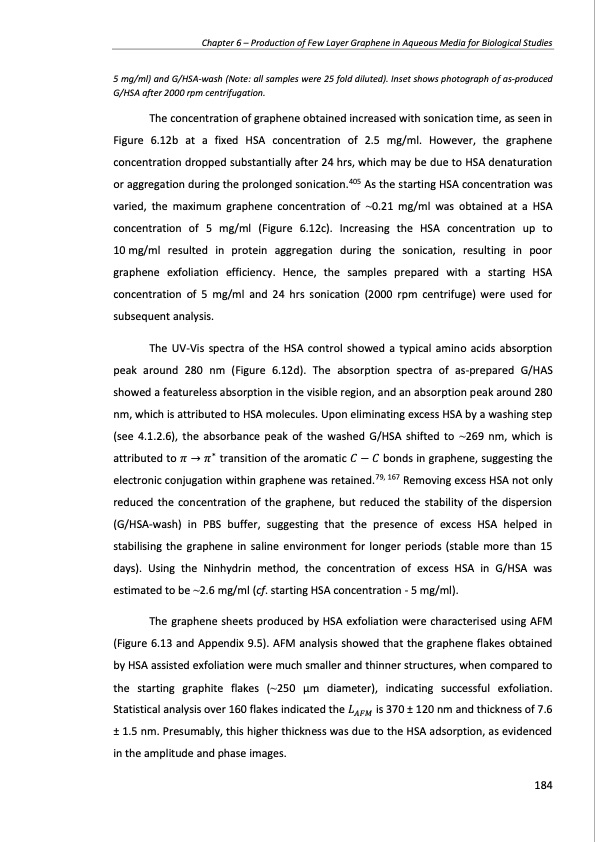
PDF Publication Title:
Text from PDF Page: 184
Chapter 6 – Production of Few Layer Graphene in Aqueous Media for Biological Studies 5 mg/ml) and G/HSA-wash (Note: all samples were 25 fold diluted). Inset shows photograph of as-produced G/HSA after 2000 rpm centrifugation. The concentration of graphene obtained increased with sonication time, as seen in Figure 6.12b at a fixed HSA concentration of 2.5 mg/ml. However, the graphene concentration dropped substantially after 24 hrs, which may be due to HSA denaturation or aggregation during the prolonged sonication.405 As the starting HSA concentration was varied, the maximum graphene concentration of ~0.21 mg/ml was obtained at a HSA concentration of 5 mg/ml (Figure 6.12c). Increasing the HSA concentration up to 10mg/ml resulted in protein aggregation during the sonication, resulting in poor graphene exfoliation efficiency. Hence, the samples prepared with a starting HSA concentration of 5 mg/ml and 24 hrs sonication (2000 rpm centrifuge) were used for subsequent analysis. The UV-Vis spectra of the HSA control showed a typical amino acids absorption peak around 280 nm (Figure 6.12d). The absorption spectra of as-prepared G/HAS showed a featureless absorption in the visible region, and an absorption peak around 280 nm, which is attributed to HSA molecules. Upon eliminating excess HSA by a washing step (see 4.1.2.6), the absorbance peak of the washed G/HSA shifted to ~269 nm, which is attributed to 𝜋 → 𝜋∗ transition of the aromatic 𝐶 − 𝐶 bonds in graphene, suggesting the electronic conjugation within graphene was retained.79, 167 Removing excess HSA not only reduced the concentration of the graphene, but reduced the stability of the dispersion (G/HSA-wash) in PBS buffer, suggesting that the presence of excess HSA helped in stabilising the graphene in saline environment for longer periods (stable more than 15 days). Using the Ninhydrin method, the concentration of excess HSA in G/HSA was estimated to be ~2.6 mg/ml (cf. starting HSA concentration - 5 mg/ml). The graphene sheets produced by HSA exfoliation were characterised using AFM (Figure 6.13 and Appendix 9.5). AFM analysis showed that the graphene flakes obtained by HSA assisted exfoliation were much smaller and thinner structures, when compared to the starting graphite flakes (~250 μm diameter), indicating successful exfoliation. Statistical analysis over 160 flakes indicated the 𝐿𝐴𝐹𝑀 is 370 ± 120 nm and thickness of 7.6 ± 1.5 nm. Presumably, this higher thickness was due to the HSA adsorption, as evidenced in the amplitude and phase images. 184PDF Image | PRODUCTION AND APPLICATIONS OF GRAPHENE AND ITS COMPOSITES

PDF Search Title:
PRODUCTION AND APPLICATIONS OF GRAPHENE AND ITS COMPOSITESOriginal File Name Searched:
graphene-production-applications.PDFDIY PDF Search: Google It | Yahoo | Bing
Salgenx Redox Flow Battery Technology: Power up your energy storage game with Salgenx Salt Water Battery. With its advanced technology, the flow battery provides reliable, scalable, and sustainable energy storage for utility-scale projects. Upgrade to a Salgenx flow battery today and take control of your energy future.
| CONTACT TEL: 608-238-6001 Email: greg@infinityturbine.com | RSS | AMP |